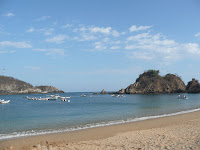
I love going to San Diego Padres games, especially early in the season when they bait all the doubters and skeptics with swag. I've collected more than my share of Padres blankets, ball caps, coolers and towels. But today, I hauled home bounty so off the wall I can only describe it as a grand slam.
I scored some awesome Toyota Terrace seats from a long-time high school/college buddy who happens to have a second home right here in "America's Finest City." And I owe Dan big time! The seats were in the shade, right off the third base line. The view was great, restrooms were close, a REAL bar with my favorite Coronado Blonde brew was nearby and a sushi bar was about as far away as second base to home plate. At Petco, it really doesn't get much better than this!
The Padres actually won the tight game against our big-time Los Angeles Dodgers rivals, which was reward enough for fans like me. And after witnessing the numerous "Man Ram" jeers each time the Dodgers favorite son, Manny Ramirez, came to the plate, I was more than satiated.
Heading back to my car, I had an experience more reserved for Petco than Petco Park. A gentleman perched on a curb outside of a condo asked my gang if any of us were interested in taking home a mini-feline cupped in his hand. I borderline collect cats, so my five-second processing of this insane proposition found me saying yes. And this was before looking at the little guy - a gray and white wee bit of a thing that reminded me of my 10-year-old Florence, who I found in Kailua on Oahu about a decade ago. Same coloring, and hopefully the same spunk and longevity.
Mind you, I'll feed little Padre (I think he's male - and if he's not, I'm not changing the name to Madre), get him healthy, get attached to him and pretend to be trying to adopt him out. After all, I don't diss my other Padre swag. So I definitely won't do it to little Padre either!


